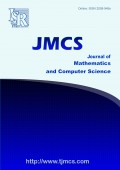

Z. Tahmasbzadehbaee - Department of Mathematics, University of Mysore, Manasagangotri, Mysore-570 006, India. N. S. Soner - Department of Mathematics, University of Mysore, Manasagangotri, Mysore-570 006, India. D. A. Mojdeh - Department of Mathematics, University of Tafresh, Tafresh, Iran.
A set \(S\) of points in graph \(G\) is a neighborhood set if \(G=\cup_{\nu\in S}\langle N[\nu]\rangle\) where \(\langle N[\nu]\rangle\) is the subgraph of \(G\) induced by \(\nu\) and all points adjacent to \(\nu\). The neighborhood number, denoted \(n_0(G)\), of \(G\) is the minimum cardinality of a neighborhood set of \(G\). In this paper, we study the neighborhood number of certain graphs.
Z. Tahmasbzadehbaee, N. S. Soner, D. A. Mojdeh, Neighborhood Number in Graphs, Journal of Mathematics and Computer Science, 5 (2012), no. 4, 265 - 270
Tahmasbzadehbaee Z., Soner N. S., Mojdeh D. A., Neighborhood Number in Graphs. J Math Comput SCI-JM. (2012); 5(4):265 - 270
Tahmasbzadehbaee, Z., Soner, N. S., Mojdeh, D. A.. "Neighborhood Number in Graphs." Journal of Mathematics and Computer Science, 5, no. 4 (2012): 265 - 270